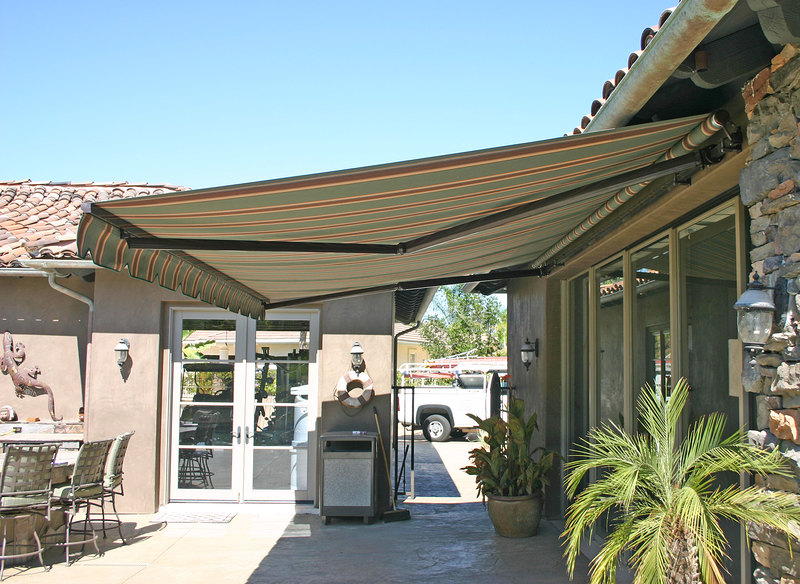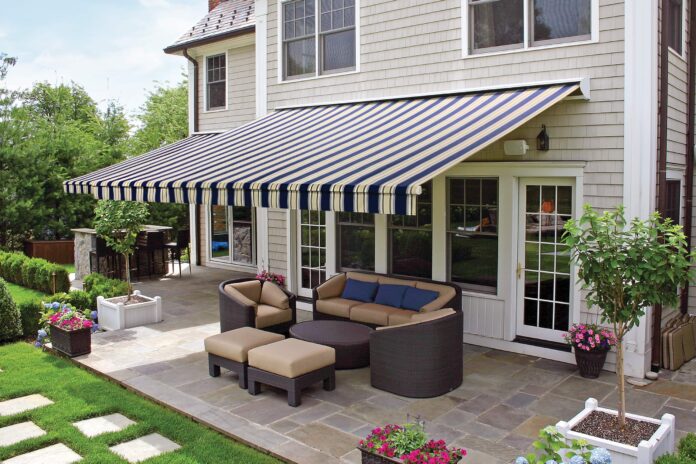An awning is a cover made of cloth or other materials stretched out over a frame to provide shade from the sun and protection from the rain. Awnings can be useful for practical reasons, like keeping you dry during a storm, but they can also be pretty and add to the look of your home.
Imagine making more room in your house and having a place where your family and friends can hang out outside. That’s where an awning comes in. It’s a type of covering that sticks out from your house’s wall and is put in a special spot above a window, door, or walkway.
The awning gives you more space to hang out outside and enjoy the nice weather. If you want an awning for your home, we can help you pick a safe and reliable one and even show you how to put it up properly.
Types of Awnings
Right now, there are many types of awnings you can buy.
Full Awning
A full awning is really big and doesn’t have to be attached to your wall. It’s made out of tent-like materials and can be twice as big as your caravan’s living room. You can hang out and relax under it; some even have fancy curtains to make it look cool.
Porch Awning
A porch awning is smaller and quicker to set up than a full awning. It’s meant for people only staying outside for a few nights. You can put it up right outside the entrance of your caravan, so people can take off their wet jackets before entering.
Canopy Awning
A canopy awning is usually attached to one side of your caravan and can be either permanent or temporary. The permanent ones have poles that make them more stable. These are harder to set up, and having a professional do it for you is better.
Stationary Awning
There are awnings that attach to the outside wall of your house. You can put them anywhere as long as they block the sun, rain, and other weather. Some of these awnings are fixed in one spot to keep a certain area shady.
However, these types of awnings can be harder to take care of and might cost more money in the long run. Since they don’t move, bad weather can put stress on them, and they might need more maintenance over time. This can add up and be expensive.
Retractable Awning
Retractable awnings do the same thing as fixed ones but can move back and forth when you want them to. This makes them versatile and a good option for patios or outdoor decks.
You can put them out when it’s really sunny, then roll them back up if you want some sun on a cooler day. Plus, they usually cost less to fix if something goes wrong.
Some models even have a motor, so you can put them out and roll them back up with the push of a button.

Patio Awnings
Patio awnings are covers that you attach to the side of your house and stretch out diagonally to provide shade over outdoor living areas. They’re great for blocking out the sun and keeping you cool.
You can get them in a couple of different types: some can be rolled up when you’re not using them, while others stay in place all the time. Usually, they’re made of fabric.
Pergola Awnings
These types of awnings usually have a wooden frame with a flat top. They’re covered with fabric that keeps the sun out and provides shade.
Sometimes, they’re attached to the side of a house. Other times, they’re free-standing in a yard, covering things like outdoor grilling areas or places to hang out by the pool.
Free Standing Awnings
A freestanding awning is a type of canopy that has a fabric top and a metal frame to provide shade. Unlike retractable or stationary awnings, these are not attached to a building and can be moved to different locations.
Door & Window Awnings
These smaller awnings are used to shade windows and doors. They keep too much sun from shining into a room, which can make it too hot.
What Materials are Used to Make Awnings?
When you’re choosing what kind of awning to get, you need to think about what you want it for. There are lots of materials to choose from, like acrylic, cotton, fiberglass, metal, vinyl, and wood.
Polyester
Polyester is a strong, waterproof synthetic material that’s great for shading you from the sun. But if it gets a lot of direct sunlight, it might start to fade.
Acrylic
Acrylic is another synthetic material that’s good at keeping moisture away. It’s a high-quality material that looks great and won’t make your home or furniture fading. Acrylic is also used to make retractable awnings that are both strong and easy to move.
Micro-Perforated Fabrics
This fabric has tiny holes in it that let air and light through. It’s perfect for really hot places where you need shade and a breeze. You can see through it too.
It’s also resistant to UV rays and easy to clean. But it can be more expensive than other materials.
Cotton
Cotton is a traditional fabric that can be stretched over a frame to create an awning.
However, to ensure that it offers proper protection, the fabric needs to have a tight weave and several layers of coating to prevent water and UV rays from penetrating through.
Fiberglass
Fiberglass is a lightweight material that is strong enough to withstand the elements. It can be used to create awnings in different colors, protecting from the sun. Although fiberglass is versatile, it can become brittle and break over time.
Metal
Metal, particularly aluminum, was the primary material used for awnings before acrylic became popular. Metal awnings are still widely used because of their durability, but they can be noisy and difficult to repair once they dent.
Vinyl
Vinyl is a very common material used for making awnings. It protects things like UV rays, rain, and strong winds.
A layer of vinyl is added to the awning to maintain its flexibility, which is particularly useful for retractable awnings. This type of awning provides excellent shade whenever needed on a patio.
Wood
In some cases, wooden awnings have been used to provide protection from the weather. Wood is an environmentally friendly material that requires minimal manufacturing effort if used correctly.
While they can be sturdy, wooden awnings don’t react well to moisture and can pose a greater fire risk to the home if the weather gets too extreme.
Benefits of Using an Awning
Installing awnings has many benefits, including practicality and aesthetic appeal. Here are some of the top reasons to install awnings on the outside of your home:
Protection for windows
Installing exterior window awnings provides protection from harsh weather conditions, particularly in areas with high winds, frequent thunderstorms, or hail.
Straight drop awnings, whether manual or motorized, can quickly add an extra layer of protection to fragile glass when the weather changes. Pivot arm canvas awnings extending over windows can also offer some degree of protection.

Window Awnings Assist in Keeping the Inside of Your House Cooler by Providing Insulation.
Awnings don’t just protect your windows, and they also help keep your home cooler. The sun can make your house really hot, even if you have blinds inside your windows.
Awnings block some sunlight from directly hitting your windows and baking your house. This means your home stays cooler and more comfortable, especially during hot Australian summers.
Enclose Your Patio And Balcony
Another benefit of installing awnings is that they can help enclose your balcony or patio area, protecting you from the elements.
For example, straight-drop awnings can shield you and your friends from the wind while you enjoy snacks and drinks outside. This is especially important for high-rise balconies that are more exposed to wind.
By having awnings that can be quickly lowered, you can continue to enjoy your outdoor space in comfort and style, regardless of the weather.
Window Awnings Have Easy Maintenance
You might worry that installing awnings on your home means you’ll have to spend a lot of time cleaning them to keep them looking nice, but modern awnings are actually really easy to take care of.
You’ll usually just need to hose them down with water every so often to keep them clean. If they get particularly dirty, you can use soapy water and a sponge to give them a deeper clean.
These days, awnings are also designed to be very strong and durable and to hold up well against bad weather.
They won’t fade in the sun or crack from being exposed to the elements, so you can expect them to last for many years without needing to be replaced.
The Home’s Exterior Design Can be Enhanced by Adding the Awnings.
Window and patio awnings have greatly improved over the past few decades. They don’t just serve a practical purpose but also come in various styles.
You can order awnings made from different materials, styles, and colors matching your home’s color scheme.
By installing awnings, you can increase the value of your home if you ever decide to sell it. The added value they bring is much more than the awnings’ cost.
Conclusion
There are many benefits of installing an awning. It makes your home feel bigger by creating more space. It also gives you a nice place to chill out in the shade when it’s super hot outside. If you need to change clothes outside, it can give you some privacy too. Plus, it can help control how much sunlight gets into your house and even keep the rain from splashing in. There are tons of ways you can use your awning to make your home better.




